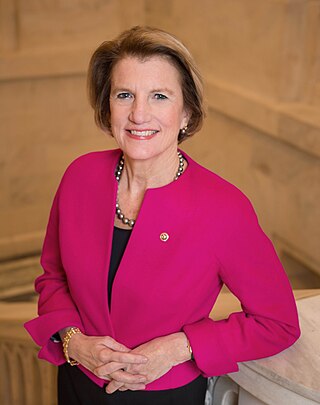
Shelley Wellons Moore Capito is an American politician and retired educator serving in her second term as the junior United States senator from West Virginia, a post she has held since 2015. A member of the Republican Party, Capito served seven terms as the U.S. representative from West Virginia's 2nd congressional district from 2001 to 2015. The daughter of three-term West Virginia governor Arch Alfred Moore Jr., she is the dean of West Virginia's congressional delegation.

Joseph Manchin III is an American politician and businessman serving as the senior United States senator from West Virginia, a seat he has held since 2010. Manchin was the 34th governor of West Virginia from 2005 to 2010 and the 27th secretary of state of West Virginia from 2001 to 2005. He became the state's senior U.S. senator when Jay Rockefeller left office in 2015 and has since been West Virginia's only congressional Democrat. Before entering politics, Manchin helped found and was the president of Enersystems, a coal brokerage company his family owns and operates.

Joe Biden, President of the United States, served as Vice President from 2009 to 2017 and in the United States Senate from 1973 until 2009. A member of the Democratic Party, he made his second presidential run in 2008, later being announced as Democratic presidential nominee Barack Obama's running mate in 2008. He was elected vice president in 2008 and re-elected in 2012. In April 2019, Biden announced his 2020 presidential campaign. He became the presumptive Democratic nominee in April 2020, was formally nominated by the Democratic Party in August 2020, and defeated Republican incumbent Donald Trump in the November 2020 election.

The American Recovery and Reinvestment Act of 2009 (ARRA), nicknamed the Recovery Act, was a stimulus package enacted by the 111th U.S. Congress and signed into law by President Barack Obama in February 2009. Developed in response to the Great Recession, the primary objective of this federal statute was to save existing jobs and create new ones as soon as possible. Other objectives were to provide temporary relief programs for those most affected by the recession and invest in infrastructure, education, health, and renewable energy.

The American Jobs Act and was the informal name for a pair of bills recommended by U.S. President Barack Obama in a nationally televised address to a joint session of Congress on September 8, 2011. He characterized the proposal as a collection of non-controversial measures designed to get Americans back to work, and he repeatedly urged Congress to pass it "right away"; he also said that the bills would not add to the national deficit and would be fully paid for.
2020s in United States history is a narrative summary of major historical events and issues in the United States from January 1, 2020, through December 31, 2029. The first part is divided chronologically by Congressional sessions and the second part highlights major issues that span several years or even the entire decade. There are links for further information.

The Coronavirus Aid, Relief, and Economic Security Act, also known as the CARES Act, is a $2.2 trillion economic stimulus bill passed by the 116th U.S. Congress and signed into law by President Donald Trump on March 27, 2020, in response to the economic fallout of the COVID-19 pandemic in the United States. The spending primarily includes $300 billion in one-time cash payments to individual people who submit a tax return in America, $260 billion in increased unemployment benefits, the creation of the Paycheck Protection Program that provides forgivable loans to small businesses with an initial $350 billion in funding, $500 billion in loans for corporations, and $339.8 billion to state and local governments.

Joe Biden's tenure as the 46th president of the United States began with his inauguration on January 20, 2021. Biden, a Democrat from Delaware who previously served as vice president for two terms under President Barack Obama, took office following his victory in the 2020 presidential election over Republican incumbent president Donald Trump. Upon his inauguration, he became the oldest president in American history, breaking the record set by Ronald Reagan. Biden entered office amid the COVID-19 pandemic, an economic crisis, and increased political polarization.

The Consolidated Appropriations Act, 2021 is a $2.3 trillion spending bill that combines $900 billion in stimulus relief for the COVID-19 pandemic in the United States with a $1.4 trillion omnibus spending bill for the 2021 federal fiscal year and prevents a government shutdown. The bill is one of the largest spending measures ever enacted, surpassing the $2.2 trillion CARES Act, enacted in March 2020. The legislation is the first bill to address the pandemic since April 2020. According to the Senate Historical Office, at 5,593 pages, the legislation is the longest bill ever passed by Congress.

The American Rescue Plan Act of 2021, also called the COVID-19 Stimulus Package or American Rescue Plan, is a US$1.9 trillion economic stimulus bill passed by the 117th United States Congress and signed into law by President Joe Biden on March 11, 2021, to speed up the country's recovery from the economic and health effects of the COVID-19 pandemic and recession. First proposed on January 14, 2021, the package builds upon many of the measures in the CARES Act from March 2020 and in the Consolidated Appropriations Act, 2021, from December.

The economic policy of the Joe Biden administration, dubbed Bidenomics, is characterized by relief measures and vaccination efforts to address the COVID-19 pandemic, investments in infrastructure, and strengthening the social safety net, funded by tax increases on higher-income individuals and corporations. Other goals include increasing the national minimum wage and expanding worker training, narrowing income inequality, expanding access to affordable healthcare, and forgiveness of student loan debt. The March 2021 enactment of the American Rescue Plan to provide relief from the economic impact of the COVID-19 pandemic was the first major element of the policy. Biden's Infrastructure Investment and Jobs Act was signed into law in November 2021 and contains about $550 billion in additional investment. His Inflation Reduction Act was enacted in August 2022.

The environmental policy of the Joe Biden administration includes a series of laws, regulations, and programs introduced by United States President Joe Biden since he took office in January 2021. Many of the actions taken by the Biden administration reversed the policies of his predecessor, Donald Trump. Biden's climate change policy focuses on reducing greenhouse gas emissions, similar to the efforts taken by the Obama administration. Biden promised to end and reverse deforestation and land degradation by 2030. The main climate target of the Biden administration is to reduce greenhouse gas emissions by the United States to net zero by 2050. John Kerry leads the effort as Special Envoy for Climate.

The first 100 days of Joe Biden's presidency began on January 20, 2021, the day Joe Biden was inaugurated as the 46th president of the United States. The first 100 days of a presidential term took on symbolic significance during Franklin D. Roosevelt's first term in office, and the period is considered a benchmark to measure the early success of a president. The 100th day of his presidency ended at noon on April 30, 2021.

Joe Biden, the 46th president of the United States, addressed a joint session of the United States Congress on April 28, 2021, the eve of his 100th day in office. It was his first public address before a joint session. Similar to a State of the Union Address, it was delivered before the 117th United States Congress in the Chamber of the House of Representatives in the United States Capitol. Presiding over this joint session was the House speaker, Nancy Pelosi, accompanied by Kamala Harris, the vice president in her capacity as the president of the Senate—the first time two women and two Californians presided over an address to Congress, seated on the rostrum behind the president.

The Infrastructure Investment and Jobs Act (IIJA), most commonly known as the Bipartisan Infrastructure Law (BIL),, is a United States federal statute enacted by the 117th United States Congress and signed into law by President Joe Biden on November 15, 2021. It was originally introduced in the House as the INVEST in America Act, and was commonly known as the Bipartisan Infrastructure Bill before it was signed into law.

The following is a timeline of the presidency of Joe Biden during the fourth and last quarter of 2021, from October 1 to December 31, 2021. To navigate between quarters, see timeline of the Joe Biden presidency.

The Build Back Better Act was a bill introduced in the 117th Congress to fulfill aspects of President Joe Biden's Build Back Better Plan. It was spun off from the American Jobs Plan, alongside the Infrastructure Investment and Jobs Act, as a $3.5 trillion Democratic reconciliation package that included provisions related to climate change and social policy. Following negotiations, the price was lowered to approximately $2.2 trillion. The bill was passed 220–213 by the House of Representatives on November 19, 2021.

The Inflation Reduction Act of 2022 (IRA) is a landmark United States federal law which aims to curb inflation by possibly reducing the federal government budget deficit, lowering prescription drug prices, and investing into domestic energy production while promoting clean energy. It was passed by the 117th United States Congress and signed into law by President Joe Biden on August 16, 2022.

The CHIPS and Science Act is a U.S. federal statute enacted by the 117th United States Congress and signed into law by President Joe Biden on August 9, 2022. The act authorizes roughly $280 billion in new funding to boost domestic research and manufacturing of semiconductors in the United States, for which it appropriates $52.7 billion. The act includes $39 billion in subsidies for chip manufacturing on U.S. soil along with 25% investment tax credits for costs of manufacturing equipment, and $13 billion for semiconductor research and workforce training, with the dual aim of strengthening American supply chain resilience and countering China. It also invests $174 billion in the overall ecosystem of public sector research in science and technology, advancing human spaceflight, quantum computing, materials science, biotechnology, experimental physics, research security, social and ethical considerations, workforce development and diversity, equity, and inclusion efforts at NASA, the NSF, the DOE, the EDA, and NIST.

The political positions of Joe Manchin encompass the established political and economic positions taken by Joe Manchin, the senior United States senator from West Virginia. Manchin's positions are reflected in his voting record, public speeches, and interviews. A member of the Democratic Party, Manchin is characterized by his self-described moderate beliefs.










